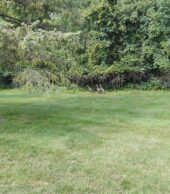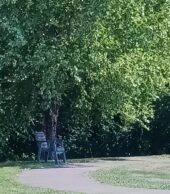Recently, my long-time friend and colleague, Eily Marlow and I developed a day-long workshop called Being Real: Practicing Humility, Courage, and Authenticity in Everyday Life. The stories and the challenges that Eily and I shared as we were preparing for the workshop have stayed with me and continued to evolve over time. So have the lessons and stories of those who participated in the workshop. In this series of blog posts, I am sharing some of those lessons and reflections in the hopes that a wider circle of people will benefit from what we have learned. This is part 1 of 4. Click here for part 2, 3, or 4 (as they are released).
Being Real (Part 1): Learning to Swim By Swimming
You get courage by [doing] courageous acts. It’s like you learn to swim by swimming. You learn courage by couraging. ~ Mary Daly
When I turned 30, I decided that I wanted to complete a triathlon. One problem: I did not know how to swim. I wasn’t scared of the water and I could stay afloat, but the most fruitful results of my childhood swim lessons were a goofy-looking breast stroke that didn’t involve putting my head under the water and a “little bird, big bird, fly.” The latter was basically laying on my back, flapping my arms, and propelling myself (slowly) through the water. These were not the ways of a triathlete.
To prepare for the swim leg of the race, I asked my spouse, Tim, to teach me how to swim a real freestyle stroke. He had been a competitive swimmer and he still swam laps regularly. Because it is difficult to learn things from loved ones and because knowing how to do something well does not automatically make someone a good teacher, we made a deal. We would try a lesson together and if it did not go well, either one of us could call it off and I would sign up for a private lesson at the YMCA. Luckily, Tim turned out to be a really good teacher.
Practicing Regularly
After getting the basics of my stroke down, I practiced regularly (sometimes with Tim’s help, sometimes alone) until I could swim decently. It still took about a year before I felt truly comfortable in the water because there are so many aspects of a swim stroke to execute at once—how to kick, where to turn your head, when to breathe, why you hold your fingers together, and how to lift your elbows. Just when I got my breathing steadied, I would stop paying attention to how I was moving my arms through the water. And just when I finally figured out how to move my arms through the water, I would realize I was barely kicking my legs anymore. Coordinating it all proved more than challenging for me.
Much of the time when I practiced at the pool, I felt embarrassed about not knowing how to swim. Teenagers half my age and seniors more than twice my age were cruising by in the lanes beside me. Meanwhile, I would pause and stand up several times during one length of the pool to reorient my body in the water after running into the lane line again. This was often humbling and sometimes humiliating.
Beginning Again
This learning experience brought me back to memories of childhood when I was such an uncoordinated runner—kicking my feet to the side in a circular motion and flailing my arms around—that my mom and dad were embarrassed to tell the other parents near the soccer field which child was theirs. Although I was not born with natural athletic ability, I became a decent athlete after many years of practicing basketball and soccer. I never did become an MVP. But I saw myself as an athlete. Being a total beginner again was difficult. I felt like I was seven years old once more.
In time, I got to the point where I could swim the full length of the pool without stopping. Later, I could swim multiple lengths of the pool. Eventually, I even became confident I would no longer embarrass myself during a triathlon.
When I would first talk to people about swimming, I used to say, “I am learning to swim so I can complete a triathlon.” Even after I became a pretty good swimmer (swimming the whole triathlon distance freestyle without stopping!), I still found myself saying, “I am learning to swim.” I just couldn’t quite say, “I am a swimmer.” I started swimming regularly, and completed three more triathlons, but swimmer seemed like a word reserved for those who did flip turns and wore wetsuits.
Saying I Am . . .
At some point, I realized that the only word I could reasonably use to describe someone who swims is swimmer. It didn't always mean fast; it didn't always mean pretty, but what else do you call someone who moves intentionally through the water three times a week? I still can’t do a flip turn. I still breathe to the same side every stroke. But I am a swimm-er.
I thought of this recently when my five-year-old asked me what it meant to be brave while listening to a song by Sara Bareillis. I heard myself say, “Brave means having courage. It means trying things even when you might be scared or embarrassed or not know how it will work out.” My bravest moments swimming weren’t during the triathlons. My bravest moments were standing up after I had hit the lane line and choosing to try again. There was no audience cheering for me. In fact, I was irritating my fellow swimmers by slowing down their swim pattern. My courage was in trying, despite being embarrassed and my uncertainty about how it would all work out.
Learning to swim is not the bravest thing I will ever do, but that process has helped me practice living with discomfort as I work toward a larger goal. My willingness to feel awkward as I learned to swim gives me more confidence navigating difficult personal conversations and entering unfamiliar settings. As I have come to learn, “couraging” involves being willing to be uncomfortable as you figure out a way forward.
Practicing Courage
A few weeks later, while listening again to Bareillis’ song (which has now become a go-to driving song), my two-year-old asked me, “Mama, are you brave?” I told her, “Yes!” Yes, Little One, I am brave. Not every moment. But I do practice courage, which makes me a “courage-er”. Our acts of courage do not always need to be big and dramatic. To practice courage, we just have to be willing to embrace the discomfort of approaching the world as beginners. Right now, for me, that means taking singing lessons for the very first time. I suppose that makes me a singer now, too.
 Learn more about the Benedictine commitment to learning.
Learn more about the Benedictine commitment to learning.
Preview all the upcoming retreats and workshops.
Learn more about Kiely Todd Roska.






